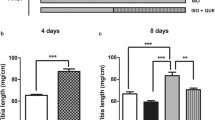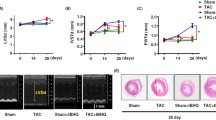Abstract
Oxidative stress is an important contributory factor for the development of cardiovascular diseases like hypertension-induced hypertrophy. Mitochondrion is the major source of reactive oxygen species. Hence, protecting mitochondria from oxidative damage can be an effective therapeutic strategy for the prevention of hypertensive heart disease. Conventional antioxidants are not likely to be cardioprotective, as they cannot protect mitochondria from oxidative damage. EUK-134 is a salen-manganese complex with superoxide dismutase and catalase activity. The possible role of EUK-134, a mitoprotective antioxidant, in the prevention of hypertrophy of H9C2 cells was examined. The cells were stimulated with phenylephrine (50 μM), and hypertrophy was assessed based on cell volume and expression of brain natriuretic peptide and calcineurin. Enhanced myocardial lipid peroxidation and protein carbonyl content, accompanied by nuclear factor-kappa B gene expression, confirmed the presence of oxidative stress in hypertrophic cells. Metabolic shift was evident from reduction in the expression of medium-chain acyl-CoA dehydrogenase. Mitochondrial oxidative stress was confirmed by the reduced expression of mitochondria-specific antioxidant peroxiredoxin-3 and enhanced mitochondrial superoxide production. Compromised mitochondrial function was apparent from reduced mitochondrial membrane potential. Pretreatment with EUK-134 (10 μM) was effective in the prevention of hypertrophic changes in H9C2 cells, reduction of oxidative stress, and prevention of metabolic shift. EUK-134 treatment improved the oxidative status of mitochondria and reversed hypertrophy-induced reduction of mitochondrial membrane potential. Supplementation with EUK-134 is therefore identified as a novel approach to attenuate cardiac hypertrophy and lends scope for the development of EUK-134 as a therapeutic agent in the management of human cardiovascular disease.






Similar content being viewed by others
References
Purushothaman S, Sathik MM, Nair RR (2011) Reactivation of peroxisome proliferator-activated receptor alpha in spontaneously hypertensive rat: age-associated paradoxical effect on the heart. J Cardiovasc Pharmacol 58(3):254–262
Ismael S, Purushothaman S, Harikrishnan VS, Nair RR (2015) Ligand specific variation in cardiac response to stimulation of peroxisome proliferator-activated receptor-alpha in spontaneously hypertensive rat. Mol Cell Biochem 406(1-2):173–182
Sankar V, Nair RR, Harikrishnan VS, Fernandez AC, Kumar CSK, Madhavachandran V (2012) Cardoguard, an Ayurvedic antihypertensive formulation, prevents cardiac remodeling in spontaneously hypertensive rats by inhibition of ERK and PKCε signaling pathways. Can J Physiol Pharmacol 90(5):627–635
Adiga IK, Nair RR (2007) A positive association between cardiomyocyte volume and serum malondialdehyde levels. Int J Cardiol 115(2):246–248
Jung C, Rong Y, Doctrow S, Baudry M, Malfroy B, Xu Z (2001) Synthetic superoxide dismutase/catalase mimetics reduce oxidative stress and prolong survival in a mouse amyotrophic lateral sclerosis model. Neurosci Lett 304(3):157–160
Browne SE, Roberts LJ, Dennery PA, Doctrow SR, Beal MF, Barlow C et al (2004) Treatment with a catalytic antioxidant corrects the neurobehavioral defect in ataxia-telangiectasia mice. Free Radic Biol Med 36(7):938–942
Melov S, Wolf N, Strozyk D, Doctrow SR, Bush AI (2005) Mice transgenic for Alzheimer disease beta-amyloid develop lens cataracts that are rescued by antioxidant treatment. Free Radic Biol Med 38(2):258–261
Brazier MW, Doctrow SR, Masters CL, Collins SJ (2008) A manganese-superoxide dismutase/catalase mimetic extends survival in a mouse model of human prion disease. Free Radic Biol Med 45(2):184–192
Peng J, Stevenson FF, Doctrow SR, Andersen JK (2005) Superoxide dismutase/catalase mimetics are neuroprotective against selective paraquat-mediated dopaminergic neuron death in the substantial nigra: implications for Parkinson disease. J Biol Chem 280(32):29194–29198
Baker K, Marcus CB, Huffman K, Kruk H, Malfroy B, Doctrow SR (1998) Synthetic combined superoxide dismutase/catalase mimetics are protective as a delayed treatment in a rat stroke model: a key role for reactive oxygen species in ischemic brain injury. J Pharmacol Exp Ther 284(1):215–221
Gianello P, Saliez A, Bufkens X, Pettinger R, Misseleyn D, Hori S et al (1996) EUK-134, a synthetic superoxide dismutase and catalase mimetic, protects rat kidneys from ischemia-reperfusion-induced damage. Transplantation 62(11):1664–1666
Rupniak HT, Joy KA, Atkin C, Brown G, Barnes JC, Doctrow SR et al (2000) Oxidative neuropathology and putative chemical entities for Alzheimer’s disease: neuroprotective effects of salen-manganese catalytic anti-oxidants. Neurotox Res 2(2-3):167–178
Bahramikia S, Yazdanparast R (2013) Inhibition of human islet amyloid polypeptide or amylin aggregation by two manganese-salen derivatives. Eur J Pharmacol 707(1-3):17–25
Decraene D, Smaers K, Gan D, Mammone T, Matsui M, Maes D et al (2004) A synthetic superoxide dismutase/catalase mimetic [EUK-134] inhibits membrane-damage-induced activation of mitogen-activated protein kinase pathways and reduces p53 accumulation in ultraviolet B-exposed primary human keratinocytes. J Invest Dermatol 122(2):484–491
Purushothaman S, Renuka Nair R, Harikrishnan VS, Fernandez AC (2011) Temporal relation of cardiac hypertrophy, oxidative stress, and fatty acid metabolism in spontaneously hypertensive rat. Mol Cell Biochem 351(1-2):59–64
Dai D-F, Hsieh EJ, Liu Y, Chen T, Beyer RP, Chin MT et al (2012) Mitochondrial proteome remodelling in pressure overload-induced heart failure: the role of mitochondrial oxidative stress. Cardiovasc Res 93(1):79–88
Sambrook J, Fritsch EF, Maniatis T (1989) Molecular cloning: a laboratory manual. Cold spring harbor laboratory press, New York
Livak KJ, Schmittgen TD (2001) Analysis of relative gene expression data using real-time quantitative PCR and the 2 [-∆∆ C[T]] Method. Methods San Diego Calif 25(4):402–408
Dai D-F, Johnson SC, Villarin JJ, Chin MT, Nieves-Cintrón M, Chen T et al (2011) Mitochondrial oxidative stress mediates angiotensin II-induced cardiac hypertrophy and Galphaq overexpression-induced heart failure. Circ Res 108(7):837–846
Redout EM, van der Toorn A, Zuidwijk MJ, van de Kolk CWA, van Echteld CJA, Musters RJP et al (2010) Antioxidant treatment attenuates pulmonary arterial hypertension-induced heart failure. Am J Physiol Heart Circ Physiol 298(3):H1038–H1047
Frantz S, Kelly RA, Bourcier T (2001) Role of TLR-2 in the activation of nuclear factor kappaB by oxidative stress in cardiac myocytes. J Biol Chem 276(7):5197–5203
Akar FG, Aon MA, Tomaselli GF, O’Rourke B (2005) The mitochondrial origin of postischemic arrhythmias. J Clin Invest 115(12):3527–3535
Aon MA, Cortassa S, Marbán E, O’Rourke B (2003) Synchronized whole cell oscillations in mitochondrial metabolism triggered by a local release of reactive oxygen species in cardiac myocytes. J Biol Chem 278(45):44735–44744
Honda HM, Korge P, Weiss JN (2005) Mitochondria and ischemia/reperfusion injury. Ann N Y Acad Sci 1047:248–258
Marchi S, Giorgi C, Suski JM, Agnoletto C, Bononi A, Bonora M et al (2012) Mitochondria-Ros Crosstalk in the control of cell death and aging. J Signal Transduct 1–17:26
Bayeva M, Gheorghiade M, Ardehali H (2013) Mitochondria as a therapeutic target in heart failure. J Am Coll Cardiol 61(6):599–610
Acknowledgments
The study was supported by the Kerala State Council for Science Technology and Environment. The authors acknowledge the support extended by the Sree Chitra Tirunal Institute for Medical Sciences and Technology, Trivandrum, for carrying out the study and publication of data.
Author information
Authors and Affiliations
Corresponding author
Rights and permissions
About this article
Cite this article
Purushothaman, S., Nair, R.R. Mitoprotective antioxidant EUK-134 stimulates fatty acid oxidation and prevents hypertrophy in H9C2 cells. Mol Cell Biochem 420, 185–194 (2016). https://doi.org/10.1007/s11010-016-2788-9
Received:
Accepted:
Published:
Issue Date:
DOI: https://doi.org/10.1007/s11010-016-2788-9




